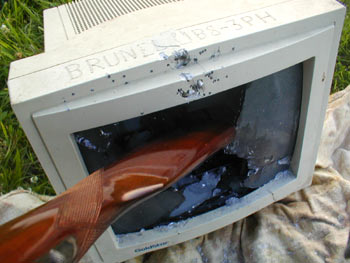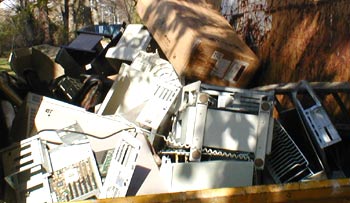
Last month I mentioned some fascinating details on planned obsolescence gleaned from a review of Giles Slade‘s Made to Break: Technology and Obsolescence in America. Having now read the book for myself, here’s my review, including noteworthy ‘architectures of control’ examples and pertinent commentary.
Slade examines the phenomenon of obsolescence in products from the early 20th century to the present day, through chapters looking, roughly chronologically, at different waves of obsolescence and the reasons behind them in a variety of fields Рincluding the razor-blade model in consumer products, the FM radio d̩b̢cle in the US, the ever-shortening life-cycles of mobile phones, and even planned malfunction in Cold War-era US technology copied by the USSR. While the book ostensibly looks at these subjects in relation to the US, it all rings true from an international viewpoint.*
The major factors in technology-driven obsolescence, in particular electronic miniaturisation, are well covered, and there is a very good treatment of psychological obsolescence, both deliberate (as in the 1950s US motor industry, the fashion industry – and in the manipulation techniques brought to widespread attention by Vance Packard’s The Hidden Persuaders) and unplanned but inherent to human desire (neophilia).
Philosophy of planned obsolescence
The practice of ‘death-dating’ – what’s often called built-in obsolescence in the UK – i.e., designing products to fail after a certain time (and very much an architecture of control when used to lock the consumer into replacement cycles) is dealt with initially within a Depression-era US context (see below), but continued with an extremely interesting look at a debate on the subject carried on in the editorials and readers’ letters of Design News in 1958-9, in which industrial designers and engineers argued over the ethics (and efficiency) of the practice, with the attitudes of major magazine advertisers and sponsors seemingly playing a part in shaping some attitudes. Fuelled by Vance Packard’s The Waste Makers, the debate, broadened to include psychological obsolescence as well, was extended to more widely-read organs, including Brooks Stevens (pro-planned obsolescence) and Walter Dorwin Teague (anti- ) going head-to-head in The Rotarian.
(The fact that this debate occurred so publicly is especially relevant, I feel, to the subject of architectures of control – especially over-restrictive DRM and certain surveillance-linked control systems – in our own era, since so far most of those speaking out against these are not the designers and engineers tasked with implementing them in our products and environments, but science-fiction authors, free software advocates and interested observers – you can find many of them in the blogroll to the right. But where is the ethical debate in the design literature or on the major design websites? Where is the morality discussion in our technology and engineering journals? There is no high-profile Vance Packard for our time. Yet.)
Slade examines the ideas of Bernard London, a Manhattan real estate broker who published a pamphlet, Ending the Depression through Planned Obsolescence, in 1932, in which he proposed a government-enforced replacement programme for products, to stimulate the economy and save manufacturers (and their employees) from ruin:
“London was dismayed that “changing habits of consumption [had] destroyed property values and opportunities for emplyment [leaving] the welfare of society … to pure chance and accident.” From the perspective of an acute and successful buinessman, the Depression was a new kind of enforced thrift.
…
London wanted the government to “assign a lease of life to shoes and homes and machines, to all products of manufacture … when they are first created.” After the allotted time expired:
“these things would be legally ‘dead’ and would be controlled by the duly appointed governmental agency and destroyed if there is widepsread unemployment. New products would constantly be pouring forth from the factories and marketplaces, to take the place of the obsolete, and the wheels of industry would be kept going… people would turn in their used and obsolete goods to certain governmental agencies… The individual surrendering… would receive from the Comptroller … a receipt… partially equivalent to money in the purchase of new goods.”
This kind of ultimate command economy also has a parallel in a Aldous Huxley’s Brave New World where consumers are indoctrinated into repetitive consumption for the good of the State, as Slade notes.
What I find especially interesting is how a planned system of ‘obsolete’ products being surrendered to governmental agencies resonates with take-back and recycling legislation in our own era. London’s consumers would effectively have been ‘renting’ the functions their products provided, for a certain amount of time pre-determined by “[boards of] competent engineers, economists and mathematicians, specialists in their fields.” (It’s not clear whether selling good second-hand would be prohibited or strictly regulated under London’s system – this sort of thing has been at least partially touched on in Japan though apparently for ‘safety’ reasons rather than to force consumption.)
This model of forced product retirement and replacement is not dissimilar to the ‘function rental’ model used by many manufacturers today – both high-tech (e.g. Rolls-Royce’s ‘Power by the Hour’) and lower-tech (e.g. photocopier rental to institutions), but if coupled to designed-in death-dating (which London was not expressly suggesting), we might end up with manufacturers being better able to manage their take-back responsibilities. For example, a car company required to take its old models back at their end of life would be able to operate more efficiently if it knew exactly when certain models would be returned. BMW doesn’t want to be taking back the odd stray 2006 3-series among its 2025 take-back programme, but if the cars could be sold in the first place with, say, a built-in 8-year lifetime (perhaps co-terminant with the warranty? Maybe the ECU switches itself off), this would allow precise management of returned vehicles and the recycling or disposal process. In ‘Optimum Lifetime Products‘ I applied this idea from an environmental point of view – since certain consumer products which become less efficient with prolonged usage, such as refrigerators really do have an optimum lifetime (in energy terms) when a full life-cycle analysis is done, why not design products to cease operation – and alert the manufacturer, or even actively disassemble – automatically when their optimum lifetime (perhaps in hours of use) is reached?

The problem of electronic waste
Returning to the book, Slade gives some astonishing statistics on electronic waste, with the major culprits being mobile phones, discarded mainly through psychological obsolescence, televisions to be discarded in the US (at least) through a federally mandated standards change, and computer equipment (PCs and monitors) discarded through progressive technological obsolescence:
“By 2002 over 130 million still-working portable phones were retired in the United States. Cell phones have now achieved the dubious distinction of having the shortest life cycle of any consumer product in the country, and their life span is still declining. In Japan, they are discarded within a year of purchase… [P]eople who already have cell phones are replacing them with newer models, people who do not have cell phones already are getting their first ones (which they too will replace within approximately eighteen months), and, at least in some parts of the world, people who have only one cell phone are getting a second or third… In 2005 about 50,000 tons of these so-called obsolete phones were ‘retired’ [in the US alone], and only a fraction of them were disassembled for re-use. Altogether, about 250,000 tons of discarded but still usable cell phones sit in stockpiles in America, awaiting dismantling or disposal. We are standing on the precipice of an insurmountable e-waste storage that no landfill program so far imagined will be able to solve.
…
[I]n 2004 about 315 million working PCs were retired in North America… most would go straight to the scrap heap. These still-functioning but obsolete computers represented an enormous increase over the 63 million working PCs dumped into American landfills in 2003.
…
Obsolete cathode ray tubes used in computer monitors will already be in the trash… by the time a US government mandate goes into effect in 2009 committing all of the country to High-Definition TV [thus rendering every single television set obsolete]… the looming problem is not just the oversized analog TV siting in the family room… The fact is that no-one really knows how many smaller analog TVs still lurk in basements [etc.]… For more than a decade, about 20 to 25 million TVs have been sold annually in the United States, while only 20,000 are recycled each year. So, as federal regulations mandating HDTV come into effect in 2009, an unknown but substantially larger number of analog TVs will join the hundreds of millions of computer monitors entering America’s overcrowded, pre-toxic waste stream. Just this one-time disposal of ‘brown goods’ will, alone, more than double the hazardous waste problem in North America.”
Other than building hundreds of millions of Tesla coils or Jacob’s ladders, is there anything useful we could do with waste CRTs?
Planned malfunction for strategic reasons
The chapter ‘Weaponizing Planned Obsolescence’ discusses a CIA operation, inspired by economist Gus Weiss, to sabotage certain US-sourced strategic and weapon technology which the USSR was known to be acquiring covertly. This is a fascinating story, involving Texas Instruments designing and producing a chip-tester which would, after a few trust-building months, deliberately pass defective chips, and a Canadian software company supplying pump/valve control software intentionally modified to cause massive failure in a Siberian gas pipeline, which occurred in 1983:
“A three-kiloton blast, “the most monumental non-nuclear explosion and fire ever seen from space,” puzzled White House staffers and NATO analysts until “Gus Weiss came down the hall to tell his fellow NSC staffers not to worry.””
While there isn’t scope here to go into more detail on these examples, it raises an interesting question: to what extent does deliberate, designed-in sabotage happen for strategic reasons in other countries and industries? When a US company supplies weapons to a foreign power, is the software or material quality a little ‘different’ to that supplied to US forces? When a company supplies components to its competitors, does it ever deliberately select those with poorer tolerances or less refined operating characteristics?
I’ve come across two software examples specifically incorporating this behaviour – first, the Underhanded C Contest, run by Scott Craver:
“Imagine you are an application developer for an OS vendor. You must write portable C code that will inexplicably taaaaaake a looooooong tiiiiime when compiled and run on a competitor’s OS… The code must not look suspicious, and if ever anyone figures out what you did it best look like bad coding rather than intentional malfeasance.”
There’s also Microsoft’s apparently deliberate attempts to make MSN function poorly when using Opera:
“Opera7 receives a style sheet which is very different from the Microsoft and Netscape browsers. Looking inside the style sheet sent to Opera7 we find this fragment:
ul {
margin: -2px 0px 0px -30px;
}The culprit is in the “-30px” value set on the margin property. This value instructs Opera 7 to move list elements 30 pixels to the left of its parent. That is, Opera 7 is explicitly instructed to move content off the side of its container thus creating the impression that there is something wrong with Opera 7.”
Levittown: designed-in privacy
Slade’s discussion of post-war trends in US consumerism includes an interesting architecture of control example, which is not in itself about obsolescence, but demonstrates the embedding of ‘politics’ into the built environment.The Levittown communities built by Levitt & Sons in early post-war America were planned to offer new residents a degree of privacy unattainable in inner-city developments, and as such, features which encouraged loitering and foot traffic (porches, sidewalks) were deliberately eliminated (this is similar thinking to Robert Moses’ apparently deliberate low bridges on certain parkways to prevent buses using them).
The book itself
Made to Break is a very engaging look at the threads that tie together ‘progress’ in technology and society in a number of fields of 20th century history. It’s clearly written with a great deal of research, and extensive referencing and endnotes, and the sheer variety of subjects covered, from fashion design to slide rules, makes it easy to read a chapter at a time without too much inter-chapter dependence. In some cases, there is probably too much detail about related issues not directly affecting the central obsolescence discussion (for example, I feel the chapter on the Cold War deviates a bit too much) but these tangential and background areas are also extremely interesting. Some illustrations – even if only graphs showing trends in e-waste creation – would also probably help attract more casual readers and spread the concern about our obsolescence habits to a wider public. (But then, a lack of illustrations never harmed The Hidden Persuaders‘ influence; perhaps I’m speaking as a designer rather than a typical reader).
All in all, highly recommended.

(*It would be interesting, however, to compare the consumerism-driven rapid planned obsolescence of post-war fins-‘n’-chrome America with the rationing-driven austerity of post-war Britain: did British companies in this era build their products (often for export only) to last, or were they hampered by material shortages? To what extent did the ‘make-do-and-mend’ culture of everyday 1940s-50s Britain affect the way that products were developed and marketed? And – from a strategic point of view – did the large post-war nationalised industries in, say, France (and Britain) take a similar attitude towards deliberate obsolescence to encourage consumer spending as many companies did in the Depression-era US? Are there cases where built-in obsolescence by one arm of nationalised industry adversely affected another arm?)